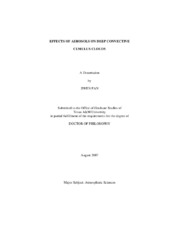| dc.description.abstract | This work investigates the effects of anthropogenic aerosols on deep convective clouds and the associated radiative forcing in the Houston area. The Goddard Cumulus Ensemble model (GCE) coupled with a spectral-bin microphysics is employed to investigate the aerosol effects on clouds and precipitation. First, aerosol indirect effects on clouds are separately investigated under different aerosol compositions, concentrations and size distributions. Then, an updated GCE model coupled with the radiative transfer and land surface processes is employed to investigate the aerosol radiative effects on deep convective clouds. The cloud microphysical and macrophysical properties change considerably with the aerosol properties. With varying the aerosol composition from only (NH4)2SO4, (NH4)2SO4 with soluble organics, to (NH4)2SO4 with slightly soluble organics, the number of activated aerosols decreases gradually, leading to a decrease in the cloud droplet number concentration (CDNC) and an increase in the droplet size. Ice processes are more sensitive to the changes of aerosol chemical properties than the warm rain processes. The most noticeable effect of increasing aerosol number concentrations is an increase of CDNC and cloud water content but a decrease in droplet size. It is indicated that the aerosol indirect effect on deep convection is more pronounced in relatively clean air than in heavily polluted air. The aerosol effects on clouds are strongly dependent on RH: the effect is very significant in humid air. Aerosol radiative effects (ARE) on clouds are very pronounced for mid-visible single-scattering albedo (SSA) of 0.85. Relative to the case without the ARE, cloud fraction and optical depth decrease by about 18% and 20%, respectively. The daytime-mean direct forcing is about 2.2 W m-2 at the TOA and -17.4 W m-2 at the surface. The semi-direct forcing is positive, about 10 and 11.2 W m-2 at the TOA and surface, respectively. Aerosol direct and semi-direct effects are very sensitive to SSA. The cloud fraction, optical depth, convective strength, and precipitation decrease with the increase of absorption, resulting from a more stable atmosphere due to enhanced surface cooling and atmospheric heating. | en |


